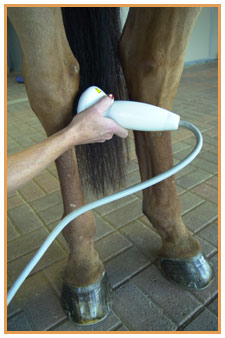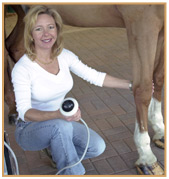
Osteoarthritis (OA), commonly referred to as arthritis or degenerative joint disease (DJD), is very prevalent in horses and is a major source of lameness. Recent estimates indicate that approximately 60% of lameness in horses is related to OA. Treating, managing and attempting to slow the progression of OA accounts for a significant amount of time and money spent by horse owners.
What is osteoarthritis?
Osteoarthritis is a progressive, irreversible deterioration of articular (in the joint) cartilage. In animals, primary osteoarthritis of an unknown cause is uncommon. In animals, osteoarthritis is generally secondary to trauma, joint instability, incongruity, immobilization, or osteochondrosis (OCD).
Osteoarthritis originates when the joint homeostasis is disrupted by abnormal cartilage and membrane cell functions, nutrition, or joint biomechanics. An imbalance in the normal joint metabolism results and the chondrocytes (cartilage cells) are unable to replace extracellular matrix that has been degraded through the presence of inflammatory mediators. This cycle progresses irreversibly as the weakened biomechanical integrity of articular cartilage leads to further dysfunction and disease. Secondarily, fibrosis around the joint will develop in efforts to stabilize the joint.
What are the signs of osteoarthritis?
An animal with osteoarthritis will generally have a history of lameness or stiffness, especially after either excessive exercise or prolonged rest. The animal may be reluctant to move. In horses, the animal may have a stiffness that they “warm out of”, a shortening of stride or a decrease in their level or quality of performance. In dogs, the first signs may be that the animal is getting up and down more slowly, is having trouble going up the stairs, jumping into the car or onto the bed.
On physical exam, the findings may include a stiff or altered gait, lameness, abnormalities during joint manipulation such as flexion tests, joint pain, decreased range of motion of joints, joint effusion (excess fluid in the joint), joint thickening, and possibly muscle atrophy from decreased use of a particular limb.
How is osteoarthritis treated?
Treatment of osteoarthritis is largely aimed at controlling the inflammation, reducing the pain associated with the inflammation, and, if possible, slowing the progression of the disease. Non-steroidal anti-inflammatories (NSAID) such as bute, and Banamine are frequently used to reduce the inflammation associated with osteoarthritis. Intra-articular (into the joint) injections of hyaluronic acid, steroids, or Adequan are also frequently employed in the treatment of osteoarthritis. While each of these treatments have a role in the treatment of OA, they also carry with them the risk of side effects such as gastric irritation and ulceration after administration of NSAID's and potentially life-threatening joint infections secondary to joint injections.
Shockwave therapy offers an exciting addition to the treatment options for osteoarthritis, with little to no risk of adverse side affects.
Using Shockwave Therapy to Treat Osteoarthritis
 Shockwave therapy has proven to be very effective at treating osteoarthritis. In a study performed at Colorado State University by Dr. Wayne McIlwraith (link to study), shockwave was found to be more effective at decreasing lameness associated with experimentally induced osteoarthritis in the knee than intramuscular Adequan injections. It was also found that shockwave therapy significantly reduced the synovitis (inflammation of the joint) associated with osteoarthritis with a reduction in the synovial fluid volume and the synovial fluid protein. Shockwave therapy has proven to be very effective at treating osteoarthritis. In a study performed at Colorado State University by Dr. Wayne McIlwraith (link to study), shockwave was found to be more effective at decreasing lameness associated with experimentally induced osteoarthritis in the knee than intramuscular Adequan injections. It was also found that shockwave therapy significantly reduced the synovitis (inflammation of the joint) associated with osteoarthritis with a reduction in the synovial fluid volume and the synovial fluid protein.
Shockwave Therapy can Alter the Progression of Osteoarthritis!
A more recent study by Moretti et.al. had exciting findings regarding the role of shockwave therapy in slowing the progression of osteoarthritis. In this study, it was found that shockwave therapy can actually alter the process of cartilage degradation by down-regulating two mediators that play a central role in the cyclical death of chondrocytes and the breakdown of the cartilage matrix that occurs in osteoarthritis. The process of cartilage breakdown is cyclical, and as more chondrocytes break down, more of these two mediators are released, leading to further breakdown of the chondrocytes. There are multiple pathways of degradation involved, and once the cycle begins, the outcome is devastating. Slowing down this process of cartilage breakdown could be a key factor in slowing the onset of lameness from osteoarthritis.
The finding that shockwave therapy can actually reduce these mediators of chondrocyte breakdown to levels found in normal joints is a major breakthrough in the study of osteoarthritis. This means that shockwave may provide a protective effect against the progression of osteoarthritis. In terms of real world usefulness, this information means that it may be indicated to use shockwave therapy earlier in the disease timeline to protect the joint and slow the onset of osteoarthritis, leading to a more active life, better quality of life, and fewer treatments with intra-articular injections and NSAIDS. Using shockwave therapy more proactively is likely to provide benefits well beyond just pain management.
Practical Uses for Shockwave Therapy
Shockwave therapy can be used successfully to treat arthritis in many joints in the horse. In a study using shockwave therapy to treat horses with arthritis of the hock that was not responding to other treatments, 80% of the horses treated improved by at least 1 degree of lameness with one treatment. Of those that did not improve, 50% were treated a second time and 50% of those horses improved 1 degree of lameness after the second treatment. In total, 86% of horses with refractory hock pain responded to 1 or 2 treatments with shockwave therapy by at least 1 degree of lameness. The duration of improvement ranged from 8 to 18 months. While these horses were patients that were no longer responding to treatment with intra-articular injections, with the new information from the Moretti study, current recommendations may be to initiate shockwave therapy in the early stages of arthritis, rather than waiting until other treatments fail.
There are several advantages to this approach. First, it appears that by using shockwave therapy early in the disease process, it may be possible to slow the progression of the disease. Secondly, there are no harmful side effects with shockwave therapy as there are with NSAIDS and intra-articular injections. Third, the results may be more long lasting with shockwave therapy, and finally, shockwave therapy is non-invasive.
In addition to hock arthritis, shockwave therapy can be used to treat arthritis in other areas of the body such as the pastern (ringbone), the fetlock (osselets), the knee, the stifle, and along the spinal column in the neck and back.
Shockwave Therapy in Dogs with Arthritis
There are a myriad of applications for shockwave therapy in the dog. Hip dysplasia is one of the most common manifestations of degenerative joint disease in the dog. Shockwave therapy has been very successful in treating hip dysplasia and providing substantial relief to affected dogs. It has been used successfully to treat people with necrosis of the femoral head, eliminating the need for hip replacement in some cases. Shockwave therapy can also be used to treat arthritis of other joints such as the knee and elbow, as well as treating chronic back pain from spondylosis, intervertebral disc disease, or lumbosacral instability. As with horses, shockwave therapy in dogs is non-invasive (sedation is required) and can provide a welcome alternative to long term non-steroidal anti-inflammatory use.
Summary
Shockwave therapy is a valuable tool in treating and managing the devastating disease of osteoarthritis. New studies indicate that shockwave therapy may actually be capable of slowing the progression of osteoarthritis as opposed to just treating the symptoms. With this information in hand, it may be indicated to use shockwave therapy early in the development of osteoarthritis, as opposed to waiting until the disease is well established and creating significant problems. Additionally, shockwave therapy has the dual advantage of being non-invasive and of having no significant adverse side affects.
In short, shockwave therapy should be considered as an integral component in the treatment plan for osteoarthritis in both the horse and the dog.
|



 Shockwave therapy has proven to be very effective at treating osteoarthritis. In a study performed at Colorado State University by Dr. Wayne McIlwraith (
Shockwave therapy has proven to be very effective at treating osteoarthritis. In a study performed at Colorado State University by Dr. Wayne McIlwraith (